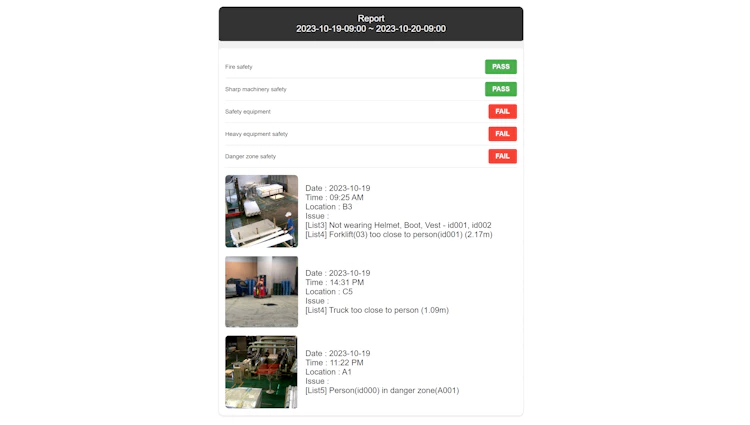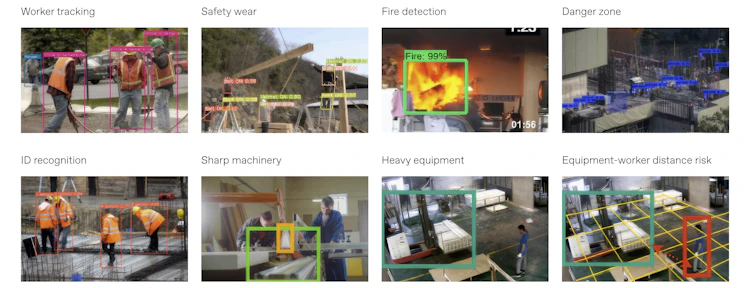Dudaji Uses FuriosaAI's Gen 1 Vision NPU to monitor workplace safety
News

Summary
-
Dudaji, a Korean AI services provider, used FuriosaAI’s Gen 1 Vision NPU card to build CV systems to monitor workplace safety in real time using the YOLO family of object detection algorithms.
-
Dudaji was able to easily export their custom models for fire detection and other tasks to Furiosa's NPU using ONNX, achieving 40FPS using YOLOv5s running eight concurrent streams.
-
Dudaji found the quality of Furiosa’s SDK and model zoo made Furiosa's Gen 1 Vision NPU an ideal solution for CV workplace safety applications.
Dudaji, a Korean company that builds custom computer vision and natural language processing solutions for businesses, is building new services that use Furiosa's Gen 1 Vision NPU accelerator for highly efficient inference at scale. As part of that work, Dudaji evaluated how well the NPU works for demanding applications, such as monitoring workplace safety, where the AI system must quickly detect complex issues such as an employee not using protective equipment or driving dangerously on a worksite.
Dudaji successfully ported a range of custom YOLO object detection models to the NPU and then optimized them through calibration and quantization. The end result was 40 FPS on eight concurrent streams using a YOLOv5s model for tasks including fire detection, worker detection, safety gear detection, and construction site monitoring.
The models were tested for performance and also for efficiency, which is critical in real-time monitoring situations where rapid and reliable inference is necessary. Peak performance was 330 FPS on a single NPU card.
“The model performs excellently in actual environments, detecting fires accurately and contributing to the prevention of fire damage,” said Dudaji’s Joonwon Lee.

End to end deployment
Dudaji began by assessing the NPU's model zoo. In evaluating a potential AI hardware solution, it’s crucial that the device supports the algorithms that will work best for a variety of applications. The YOLO family of models has become an industry standard because of its ability to perform real-time object detection in a single pass, making it much faster than traditional CNNs. Furiosa's Gen 1 Vision NPU supports YOLOv5m, YOLOv5L, and YOLOv7w6Pose (for pose estimation).
Furiosa's Gen 1 Vision NPU is available on Kakao Cloud, allowing Dudaji to easily access the NPU instance remotely and test the Furiosa SDK's compatibility with public models and custom algorithms. Dudaji confirmed the SDK is compatible with major AI frameworks like PyTorch and TensorFlow Lite.
The SDK allows engineers to easily convert Torch models to the ONNX format so they can calibrate and quantize using ImageNet samples.

The models specializing in a variety of workplace safety tasks.
Optimization
Dudaji performed distributed parallel execution of experiments to select models based on quantitative metrics (time accuracy) and various quantization algorithms (e.g., MIN_MAX_ASYM, ENTROPY_ASYM) suitable for different datasets. Dudaji found that MinMax calibration was most effective.
{
"model_name": "resnet50_01",
"inference_engine": "onnxruntime",
"image": "dudaji/quant-simul-cl-onnxruntime",
"module_root_path": "module/resnet50",
"input_model_path": "module/resnet50/input_model.onnx",
"data_location_type": "file",
"val_dataset": "dataset/imagenet",
"calib_dataset": "dataset/imagenet/data",
"algorithm": [
"ORG",
"KL",
"PC3",
"PC4",
"PC5",
"MinMax"
],
"targets": [
{
"data_names": [
"time",
"accuracy"
],
"regex": "Last Time: (\\d+\\.\\d+) ms Accuracy: (\\d+\\.\\d+)%"
}
],
"target_end": "benchmark ended",
"sample_size": 500,
"test_size": 500
}
{
"id": "645214edbe2f90a7f700e3c2",
"algorithm": [
"ORG",
"KL",
"PC3",
"PC4",
"PC5",
"MinMax"
],
"val_dataset": "dataset/imagenet",
"calib_dataset": "dataset/imagenet/data",
"ORG": {
"time": "166.75",
"accuracy": "73.65269"
},
"KL": {
"time": "112.87",
"accuracy": "73.05389"
},
"PC3": {
"time": "96.19",
"accuracy": "39.72056"
},
"PC4": {
"time": "107.39",
"accuracy": "71.45709"
},
"PC5": {
"time": "104.19",
"accuracy": "72.65469"
},
"MinMax": {
"time": "112.56",
"accuracy": "73.05389"
}
}
This is an example of a JSON-formatted configuration request.
id 645214edbe2f90a7f700e3c2
algorithm ['ORG', 'KL', 'PC3', 'PC4', 'PC5', 'MinMax']
val_dataset dataset/imagenet
calib_dataset dataset/imagenet/data
ORG {'time': '166.75', 'accuracy': '73.65269'}
KL {'time': '112.87', 'accuracy': '73.05389'}
PC3 {'time': '96.19', 'accuracy': '39.72056'}
PC4 {'time': '107.39', 'accuracy': '71.45709'}
PC5 {'time': '104.19', 'accuracy': '72.65469'}
MinMax {'time': '112.56', 'accuracy': '73.05389'}
The "MinMax" algorithm provided the best combination of speed and accuracy.
In testing the YOLOv5s model, Dudaji found that preprocessing took between 4 and 10 minutes (including model optimization, calibration, and quantization), and inference operated at approximately 40 FPS.

Dudaji reported high levels of operational stability with Furiosa's Gen 1 Vision NPU, even under continuous operation and in scenarios simulating overload conditions. Dudaji’s engineers assessed the NPU's stability during prolonged continuous operation and in overload situations, finding that there were no hardware faults or other errors over the project’s six-month test period. This reliability is crucial for ensuring uninterrupted safety monitoring in critical work environments.
Dudaji is now preparing to work with FuriosaAI to port additional applications (e.g., detecting copyright infringement and language translation) to Furiosa’s second-gen chip, RNGD (pronounced "Renegade"), which will launch later in 2024.




